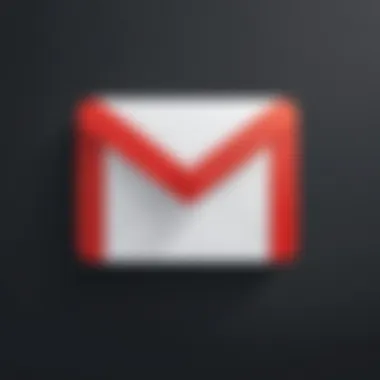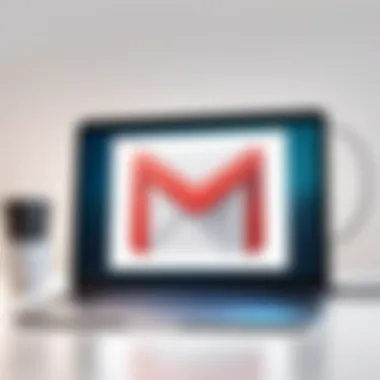Create Your New Gmail Account: Easy Steps Explained


Intro
In the digital world we inhabit today, crafting a reliable email address is not just a nicety; it's a necessity. From connecting with colleagues to signing up for online services, a robust email account facilitates numerous interactions. Among various email providers, Gmail stands out, noted for its user-friendly features and integration with Google’s suite of applications. This guide aims to walk you through the subtle art of creating a new Gmail account.
Along the way, we’ll touch upon key points like the prerequisites you might consider before diving in. Also, we’ll discuss significant details related to account management to help you make the most of your Gmail experience. Whether you are entirely new to digital communications or simply looking to streamline your online dealings, this guide is tailored for you.
Creating an email address isn’t just about filling out a form; it's about establishing a channel for communication in an increasingly interconnected world. Here’s what to expect as you step into the world of Gmail.
Understanding Email Platforms
In today’s digital landscape, email remains a cornerstone of communication. It’s just about everywhere, and understanding email platforms like Gmail is essential for navigating today’s interconnected world. This section delves into the significance of these platforms, particularly emphasizing Gmail’s unique offerings that make it stand out in a crowded field.
What is Gmail?
Gmail is Google’s email service that has carved a niche for itself among the multitude of choices available. Launched in 2004, it has grown to become one of the most widely used email platforms globally. With a simple interface and solid performance, Gmail allows users to send and receive messages, share files, and organize their communication efficiently. It integrates seamlessly with other Google services, allowing easy access to Drive, Calendar, and even Google Meet.
But it’s not just about sending emails; it’s about creating an ecosystem that supports productivity and enhances communication. Many users appreciate the clean aesthetic and the intelligent features like smart compose and automatic filtering, which help to refine the experience. Furthermore, Gmail offers a generous storage limit, making it a sensible choice for both personal and professional use.
Gmail also provides a mobile app that maintains most of the functionalities of its web version. This allows users to stay connected on the go, a key advantage in today’s fast-paced environment.
Importance of Email in Modern Communication
In our contemporary society, email is not merely a tool for sending messages. It serves as a crucial means of official and informal exchanges alike. Understanding the role of email in modern communication underscores its benefits:
- Professional Correspondence: Email acts as a primary method for formal communication in business contexts. Receiving updates, attending meetings, and negotiating deals often take place through emails.
- Documentation: Email provides a written record of communications, an invaluable asset for both personal use and legal considerations. Users can easily reference past correspondence, making organization and accountability relaxed.
- Global Reach: With just an internet connection, emails can be sent across the globe in seconds, connecting individuals regardless of geographical barriers.
Additionally, the popularity of email for newsletters, promotional offers, and other forms of outreach shows its versatility. Despite the rise of instant messaging and social media, email maintains its place as a reliable and essential form of communication. It is often said that, "If you want to get ahead in business, you must stay ahead in communication; email helps do just that!"
In summary, understanding platforms like Gmail is foundational as one embarks on the journey of email communication. As the need for efficient, organized, and secure communication grows, choosing the right email platform is a critical step toward ensuring productive interactions.
Prerequisites for Creating a Gmail Account
Before you dive into the process of creating a Gmail account, it's crucial to grasp the prerequisite elements that lay the groundwork for a smooth registration experience. Understanding these prerequisites not only saves time but also ensures that you set up your account with all the necessary components right from the start. This section will cover the key information, device requirements, and the significance of having a stable internet connection.
Necessary Information
Starting with necessary information, it’s like laying down the basic building blocks before constructing a house. For instance, you'll need some personal details such as your name, desired email address, and a phone number for verification purposes. The email address you choose should be unique, as it will define your digital identity within the Gmail ecosystem.
Furthermore, a phone number is not just a formality—it's a vital tool for account recovery. If you ever find yourself locked out, this number can come to the rescue, helping you regain access to your account. Make sure that the information provided is accurate; it can save you from a world of headache later. In summary, getting these key pieces of information sorted is essential for a seamless registration process.
Electronic Device Requirements
Now let’s talk about the electronic device requirements. You don’t necessarily need the latest tech gadget to create a Gmail account, but your device must be capable enough to access the internet, which is a basic requirement. A smartphone, a tablet, or even a computer will do just fine.
In addition, ensure that your browser is updated. Outdated browsers can cause compatibility issues, which may frustrate you during the account creation process. If your device has a functioning web browser, you are good to go. This makes using Gmail accessible to nearly everyone, from tech-savvy users to those just learning the ropes.
Stable Internet Connection
Finally, let’s not overlook the significance of a stable internet connection. Attempting to create a new account while battling with a flaky connection can set you up for a frustrating experience. Imagine filling out that registration form, hit submit, and—bam!—the page doesn’t load.
A reliable internet connection ensures that your actions are promptly recorded and that you can receive any verification codes without delay. Consider this: if your connection is spotty, it may lead to failed submissions or errors arising during the process. To put it simply, a stable connection makes the entire operation smooth and efficient.
In short, having the right information, a capable device, and a reliable internet connection sets a solid foundation for creating your new Gmail account.
By focusing on these prerequisites, you're not just preparing yourself; you're gearing up for a hassle-free experience that puts you one step closer to accessing the myriad of features Gmail has to offer.
Accessing the Gmail Registration Page


Accessing the Gmail registration page is the gateway to establishing your email presence, acting as a crucial step in the journey of creating a new Gmail account. This part of the process, while seemingly simple, lays the foundation for every subsequent action you will take within the platform. For anyone seeking a digital foothold, knowing how to effectively navigate to the right spot on the web is pivotal.
Navigating to the Gmail Website
To access the Gmail registration page, you start by opening a web browser on your device. This could be anything from Google Chrome, Safari, or Firefox. The next step is typing in the URL: . As you hit enter, you’ll be greeted by a clean and simple landing page. This is not just any website; it’s the threshold to a world of communication.
It’s essential to ensure that you're on the official Gmail site. Watching out for look-alike sites is crucial since there are many impostors out there. The lock icon beside the URL indicates you’re on a secure page, which is a good sign. A little caution can save you from potential headaches down the line.
Identifying the Sign-Up Option
Once on the Gmail homepage, look for the bright blue button that says “Create account.” This button is your next step toward crafting your new email address. It’s typically positioned right below where you see options for sign-in. Identifying the sign-up option may seem straightforward, but it’s an important part of the process.
Here’s where some folks might trip up. Make sure to select the right option—whether it's for business, personal use, or another purpose—because this choice influences the kind of interface and features you'll encounter later on. After clicking this button, you will be directed to the next page where you'll start filling in your details to set up your account.
"Accessing the Gmail registration page is a pivotal first step toward establishing a digital identity in today's interconnected world."
By understanding these intricacies, you'll not only expedite the process but ensure that it’s done securely and correctly.
Step-by-Step Process to Create a New Account
Creating a new Gmail account may seem as simple as pie, yet the process involves particular steps that, when followed precisely, guarantee a successful registration. This approach provides users with not just an email address, but a gateway to numerous digital services and enhanced communication. Understanding this step-by-step process can prevent common pitfalls and save time. Each element in this procedure contributes significantly to establishing a secure and effective email account.
Filling Out the Registration Form
Filling out the registration form stands as the first major hurdle in creating a new Gmail account. Google’s form is straightforward, yet it demands attention to detail to ensure accuracy. You'll be prompted to enter essential details like your name, desired email address, and a password. Consider the following:
- Choosing Your Email Address: It's more than just a string of letters. A unique and memorable email address serves as your online identity. Avoid numbers that make it hard to remember, unless they hold personal significance.
- Personal Information: Gmail asks for basic information, which may feel intrusive; however, it is pertinent for account recovery and personal verification.
Your email address needs to resonate with who you are. Keep in mind that this is how you will be recognized in the digital space; hence, try to keep it professional if it's intended for job applications or formal communication.
Creating a Strong Password
Once you’ve tackled the personal information, the next step is developing a password that is as impenetrable as a fortress. This is crucial in today’s security climate where cyber threats loom large. Here are some pointers for crafting a strong password:
- Length Matters: Aim for at least 12 characters. Longer passwords are harder to crack.
- Mix It Up: Use a combination of uppercase, lowercase, numbers, and symbols. A password like is far stronger than .
- Avoid Common Pitfalls: Stay clear of easily guessable information such as birthdays or names. Cybercriminals often exploit this information, so think outside the box.
A robust password not only protects your email but bolsters your entire online presence. Don't hesitate to utilize a password manager, as they can help you keep track of complex passwords without the risk of recalling them all.
Verification of Identity
The verification step acts as a security sentinel for your new Gmail account. Depending on the information you provided, Google will prompt you to verify your identity, usually through a mobile number or alternative email.
- Why This is Crucial: Verification is designed to ensure that you’re the rightful owner of the information entered on the registration form. It prevents unauthorized access, which is vital considering the personal data often stored in email accounts.
- Steps in Verification: Usually, Google will send a verification code to the provided mobile number. Enter this code when prompted to confirm you are indeed setting up this account. If you are using a different email, check that inbox for your verification code.
"Verifying your identity is not just a formality, it is an integral layer of your online security that should never be overlooked."
In summary, each of these steps, from filling out the registration form to verifying your identity, plays a pivotal role in establishing not only a Gmail account but a solid foundation for your entire digital correspondence. Ensuring accuracy and prioritizing security can eliminate headaches and pave the way for smoother future interactions.
Finalizing Your Gmail Account
Finalizing your Gmail account is not just a mere formality; it's the capstone of the account creation process. It encompasses essential steps that ensure your email experience is secure, tailored, and efficient. Neglecting this phase can lead to vulnerabilities that can compromise your privacy or result in lost access when you need it the most. Therefore, let's dive into the specifics of wrapping up your Gmail account with finesse.
Agreeing to Privacy Policies
When you set up a Gmail account, agreeing to the privacy policies is very important. These policies outline how Google collects, uses, and manages your data. It's vital to read through this information, even if it's easy to skip. For instance, Google states how email contents might be scanned for personalization and advertising. Being aware of these practices enables you to decide what you’re comfortable with. Furthermore, knowing your rights helps in maintaining control over your personal information in the digital world.
- Understand Terms: Familiarize yourself with terminologies like "data retention" and "user consent."
- Make Informed Choices: Decide if you want to enable certain features knowing the privacy implications.
- Future Reference: Save the link to the privacy policy for later review if necessary.


Setting Up Recovery Options
Setting up recovery options for your Gmail account is akin to having a safety net in your life. Think of it as leaving a spare key with a trusted friend rather than just hiding it under the mat. Recovery options help you regain access to your account in case you forget your password or if someone attempts to compromise your account.
- Phone Number: Adding your phone number allows Google to send you verification codes. This step enhances the security of your account significantly.
- Alternative Email: Providing a second email address ensures that if you ever lock yourself out, you have a backup plan.
- Security Questions: While not as common anymore, some may find adding security questions beneficial. Just ensure you remember them and they are not easily guessable.
Overall, having these recovery options in place reduces stress down the line, making it easier to regain control when necessary.
Exploring the Inbox Interface
Once your account is finalized, the next logical step is to familiarize yourself with the Gmail interface. The inbox is your command center, where you manage your email flow effectively. Gmail's layout is designed for efficiency, but it may take time to find all the features.
- Tabs: Gmail employs a tabbed structure for organization, separating Primary, Social, and Promotions. This allows for streamlined navigation through various categories.
- Search Bar: Positioned at the top, the search bar enables rapid access to any specific email. Utilizing operators can further enhance your search capabilities.
- Settings: The gear icon takes you to the settings menu, where you can customize various elements, from themes to inbox layout.
Understanding how to maneuver through your inbox is crucial for maintaining clear communication. It helps reduce clutter and saves time, allowing you to focus on what truly matters in your digital correspondence.
"Your Gmail inbox is the central hub of your online communication, a space where organization meets functionality."
With these finalizations complete, your Gmail account is not just functional; it's optimized for a tailored user experience.
Tips for Managing Your New Gmail Account
Managing your new Gmail account effectively is vital for optimizing your communication experience. As email becomes one of the primary channels for both personal and professional correspondence, organizing it well can save you a lot of time and prevent important messages from getting lost in the clutter. Consequently, knowing how to navigate your Gmail settings can lead to a more efficient use of this tool, ensuring you stay on top of your emails and communications.
Organizing Emails with Labels and Folders
To keep your inbox neat and tidy, utilizing labels and folders in Gmail is a game changer. Gmail allows you to assign labels to emails, which function in a similar manner to folders but with greater flexibility. You can label messages by project, client, or any classification that makes sense to you. Here's how you can get started:
- From the left panel in Gmail, you can click on "More" and then select "+ Create new label."
- As you receive emails, apply relevant labels by selecting the email and clicking on the label icon.
This labeling approach helps in retrieving emails quickly, making it notably simpler to find what you need without wading through piles of messages. It almost feels like having a personal assistant who knows exactly where everything is.
Furthermore, using nested labels (labels within labels) can add another layer of organization. For instance, you could have a primary label called "Work" and nested labels such as "Marketing" and "Client Communications" beneath it. This creates a hierarchy that suits your workflow.
Utilizing Filters for Efficiency
Gmail’s filter feature can be your best friend when it comes to maintaining an organized inbox. Filters let you automatically manage incoming emails based on specified criteria, such as sender, subject, or keywords. This automation not only saves time but also ensures that your attention remains focused on the most pertinent messages. Setting up filters can look something like this:
- Click the gear icon (Settings) on the upper right corner and go to "See All Settings".
- Navigate to the "Filters and Blocked Addresses" tab.
- Create a new filter and determine your criteria (like emails from certain senders or containing specific words).
- Choose actions, such as archiving, labeling, or forwarding the email.
Once filters are established, your inbox can mostly manage itself, freeing you up for more important tasks. Imagine waking up to a perfectly organized inbox!
Accessing Gmail on Mobile Devices
In today's fast-paced world, accessing Gmail on your mobile device is essential. Thankfully, Google has made it effortless to keep your email at your fingertips, whether you're on your daily commute or sitting in a café. The Gmail app is available for both Android and iOS devices.
After downloading and installing the app, logging in is simple using the credentials of your new email account. The app interface is user-friendly and offers features that mirror those of the desktop version, including:
- Email categorization using tabs
- Access to labels and folders
- Real-time notifications for new emails
- The ability to manage your calendar and tasks alongside email
With Gmail on your phone, you can respond to job inquiries or manage personal communications without needing to be tethered to a computer. This flexibility opens up more opportunities for productivity, allowing you to check or send emails on the go, which is invaluable for anyone these days.
"A well-managed inbox is not just a convenience; it's a necessity in our information-rich world."
Understanding and mastering these tips will undoubtedly enhance your experience with Gmail, making it a powerful tool for achieving better organization and communication.
Common Issues in Account Creation


Creating a new Gmail account can often feel like assembling a complex puzzle where you are missing a few key pieces. Sometimes, you might run into roadblocks that can be frustrating. Addressing these common issues during the account creation process not only simplifies things but also empowers users to navigate these challenges with ease.
Understanding common pitfalls is crucial for a seamless experience. Not only does it save time, but it also minimizes the risk of abandoning the sign-up process altogether. This section delves into typical problems one might encounter and offers practical solutions. These insights can turn a tricky situation into a smooth run.
Error Messages During Sign-Up
When commencing the creation of a Gmail account, it's not uncommon to stumble upon a variety of error messages. These messages often serve as the gateway to understanding what went awry. A frequent issue is encountering a message indicating the chosen email address is already in use. This typically occurs when another user has registered the handle you've opted for, leaving you with a dilemma.
To circumvent this, it's advisable to experiment with variations of your desired email. Adding numbers or a middle initial can often do the trick.
Another common error message may involve password requirements. Gmail has specific stipulations for passwords. If your password fails to meet their complexity requirements, you may see a notification suggesting you strengthen it. The best path forward is to include a mix of uppercase letters, lowercase letters, numbers, and symbols. This not only adheres to Gmail’s protocols but also elevates your account's security.
"An ounce of prevention is worth a pound of cure."
Troubleshooting Common Problems
Now, just because you run into a few hiccups doesn’t mean all hope is lost. Knowing how to troubleshoot effectively can make all the difference.
- Revisiting Input Details: Oftentimes, simple typographical errors can derail the whole process. Double-checking your entered information can help catch any pesky mistakes.
- Clearing Browser Cache: If things are still not clicking, clearing your browser's cache can sometimes resolve unexplained issues. Browsers can hold onto outdated data that may conflict with the latest sign-up procedures.
- Switching Browsers: If you're still hitting walls, trying a different web browser might be a solution worth exploring. Compatibility issues can occasionally arise.
Lastly, it’s smart to keep your device’s software up-to-date. Sometimes, glitches can arise simply because the software you’re using hasn’t been updated in a while.
In the event none of the above remedies work, reaching out to Google support can provide additional guidance to get you back on course. It's like having a safety net when things go awry.
Importance of Email Security
In our increasingly digital world, the necessity of maintaining robust email security cannot be overstated. With the vast amounts of personal and professional information that we share via email, ensuring this communication is safeguarded is paramount. Email security encompasses various practices and technologies designed to protect email accounts and their contents from unauthorized access, spam, phishing attacks, and other malicious activities. Cyber threats are evolving every day, and email remains a primary target for attackers due to its ubiquity.
Consider this: every time you send an email, whether it’s to a colleague at work, a friend, or even a delivery service, you are potentially exposing valuable personal data. Let's break down why it’s crucial not just for individuals but also for organizations.
- Protection Against Cyberattacks: Phishing attacks, where attackers masquerade as trustworthy entities, often aim to trick recipients into revealing confidential information. Understanding these threats is the first step toward protection. Luckily, you can effectively reduce the risk by applying proper security protocols, including user education, but it’s also essential to utilize technology effectively.
- Safeguarding Sensitive Information: For businesses, protecting customer data is not just about following regulations; it’s about maintaining trust. If a client feels their data is unsafe, they are likely to seek services elsewhere. Email encryption and the implementation of secure servers help keep proprietary and sensitive information under wraps.
- Maintaining Professional Integrity: A compromised email account can lead to unwanted reputational damage. Spam messages, data leakage, and unauthorized communications can seriously harm an organization's credibility. Thus, ensuring email accounts are fortified strengthens not just individual privacy but corporate integrity.
Overall, prioritizing email security goes a long way. It’s more than just a good practice; it’s a necessary strategy for navigating the digital landscape.
Understanding Phishing Attacks
Phishing attacks are deceptively simple yet devastatingly effective. Essentially, they occur when a malicious actor sends an email that appears to be from a legitimate source, aiming to trick individuals into providing sensitive information such as passwords or credit card numbers. You may ask yourself why this is relevant, but it can happen to anyone. Anchoring your understanding in good practice is key to ensuring you aren't caught off guard.
- Types of Phishing: There are several varieties, including email phishing, spear phishing (targeted attacks), and whaling (aimed at senior executives). Awareness of these types can help you recognize threats more effectively.
- Signs of Phishing: Users should be wary of unsolicited emails that solicitate action, especially those containing links or attachments. Always check the sender’s email address, as it’s often a slight variation of a legitimate business.
- How to Protect Yourself: You can install anti-phishing software, enroll in security programs, and foster awareness about the latest phishing trends and tactics.
Enabling Two-Step Verification
Two-step verification (2SV), also known as two-factor authentication (2FA), adds an extra layer of security to your Gmail account. By requiring not only a password but also a second method to confirm your identity, it effectively keeps your account safer from unauthorized access. Here’s why enabling it is nothing short of essential:
- Increased Security: Even if a hacker somehow obtains your password, they will not easily gain access unless they can also provide the second verification factor. This could be a text message sent to your mobile phone or an authenticator app.
- Peace of Mind: When you know you've implemented 2SV, you can breathe a little easier. The confidence that your email account has enhanced protection allows you to focus on more pressing matters.
- Simple Setup: Enabling two-step verification on your Gmail account is straightforward. Just visit your account settings, select 'Security', and follow the prompts to choose your preferred method of verification.
Always stay one step ahead with your security measures. It's easier to prevent a breach than to fix it afterward.
The End
In this rapidly moving digital age, having a reliable email account is essential. This article has taken a thorough look at the steps involved in creating a new Gmail address, emphasizing not only the technical aspects but also the broader implications of utilizing Gmail effectively.
Setting up your Gmail account is more than just filling out a form; it’s about establishing a gateway to communication, both personal and professional. The clarity and ease with which you navigate the Gmail creation process can influence how smoothly you manage your digital life.
Recap of the Gmail Creation Process
Creating a new Gmail account follows a systematic approach consisting of several important steps:
- Prerequisites: Before diving into the registration process, ensure you have all necessary information at hand, like your personal details and preference for a new email address.
- Accessing the Registration Page: Direct your browser to Gmail’s website and locate the sign-up option, which usually stands out clearly.
- Registration Form: Fill out the required fields carefully. Be sure to choose an email address that reflects your identity but isn’t too complicated.
- Password Creation: Creating a strong password is crucial for protecting your account. Mix upper and lower case letters with numbers or symbols for enhanced security.
- Identity Verification: After submitting your form, you’ll typically go through verification processes, often receiving a code on your phone or via another email account.
- Finalization: Agree to privacy policies, set recovery options, and take a tour of the inbox interface to familiarize yourself with the layout.
Following this clear structure ensures that no steps are missed while creating your Gmail account. As you settle into your new account, remember that proper management and awareness regarding issues like security can enhance your overall user experience. With a strong grasp of what it takes to create and maintain your Gmail account, you’re poised not just to communicate but to leverage your digital correspondence effectively in both social and professional realms.
"An email address isn't just a string of characters; it symbolizes a slice of your digital identity."
With these insights, you should feel confident to set up your Gmail account and immerse yourself in the multitude of features it offers.



